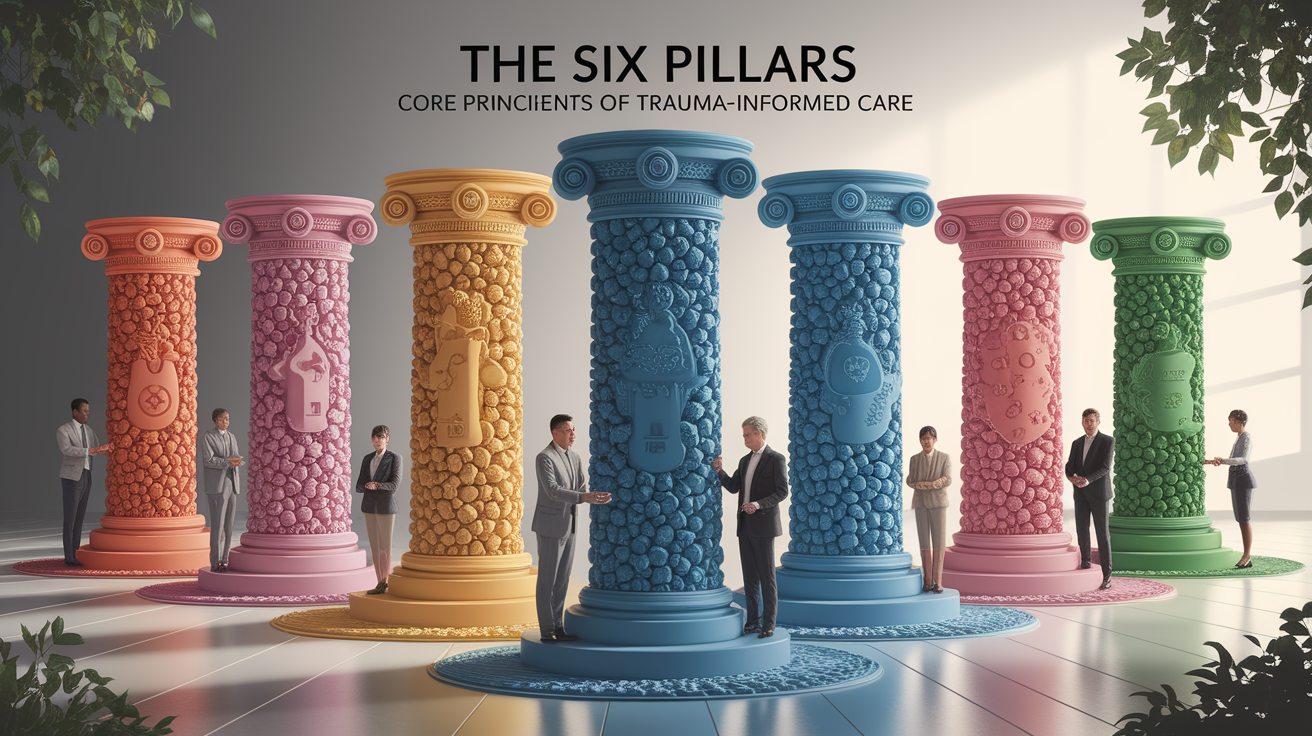Trauma-Informed Care: A Practical Guide to Safety and Healing
Opening the Door: Why Trauma-Informed Matters
In fields from social work and healthcare to education and the justice system, a profound shift is underway. This shift moves away from asking, “What is wrong with this person?” to a more compassionate and effective question: “What has happened to this person?” This is the essence of Trauma-Informed Care (TIC), a framework that recognizes the pervasive impact of trauma on an individual’s life and well-being. It is far more than a set of techniques; it represents a deep organizational change process aimed at creating environments of healing and recovery.

Trauma, stemming from events like Adverse Childhood Experiences (ACEs), violence, or systemic oppression, can be terrifying and overwhelming, fundamentally altering a person’s sense of safety and self-worth. A trauma-informed approach acknowledges this reality and makes a conscious commitment not to repeat these traumatic experiences. Instead, it seeks to prevent re-traumatization by transforming interactions, policies, and physical environments. The goal is to move beyond simply treating symptoms and instead foster genuine resilience and recovery by restoring a sense of safety, power, and dignity.
It’s crucial to distinguish between being “trauma-informed” and providing “trauma-specific” services. Trauma-specific interventions are clinical treatments like Eye Movement Desensitization and Reprocessing (EMDR) or Trauma-Focused Cognitive Behavioral Therapy (TF-CBT), designed to directly address trauma symptoms. Trauma-informed care, on the other hand, is a universal framework. It’s an approach that an entire organization or system adopts to ensure every interaction and policy is sensitive to the potential for trauma, creating a foundation upon which specific treatments can be more effective.
The Six Pillars: Core Principles of Trauma-Informed Care
A truly trauma-informed approach is built upon a foundation of six key principles, often traced back to the Substance Abuse and Mental Health Services Administration (SAMHSA). These pillars guide organizations in shifting their culture and practices to be centered on healing and safety. They provide a comprehensive overview of how to structure a responsive and supportive system.
1. Safety
The primary pillar is the creation of both physical and psychological safety. Trauma shatters a person’s sense of security, and healing cannot begin until that is re-established. Physical safety involves ensuring the environment is free from threats, while psychological safety means creating an atmosphere where people feel respected, validated, and free from shame or judgment. This can be as simple as having a calm, welcoming waiting area or as complex as redesigning intake procedures to be less intrusive.
2. Trustworthiness and Transparency
Trust is often a casualty of trauma. To rebuild it, organizations must operate with unwavering trustworthiness and transparency. This means that decisions and rules are communicated clearly and consistently. For clients, it means knowing what to expect in every interaction. For staff, it means feeling that leadership is open and honest. Building trust is a deliberate process that underpins every other principle.

3. Peer Support and Mutual Self-Help
There is immense power in shared experience. Integrating peer support—individuals with lived experience of trauma and recovery—into the service model is a core component of TIC. Peers can offer unique insights, model resilience, and build trusting relationships in ways that professionals sometimes cannot. This principle acknowledges that healing is not just a top-down process but a journey of mutual self-help and collective support.
4. Collaboration and Mutuality
A trauma-informed approach flattens traditional power hierarchies. It recognizes that healing happens within relationships built on respect and mutuality. Decisions are made *with* individuals, not *for* them. This collaborative spirit extends to all levels of an organization, where staff and clients work together to co-create plans, policies, and procedures, ensuring everyone has a meaningful role in the healing process.
5. Empowerment, Voice, and Choice
Trauma robs individuals of their sense of control and agency. A primary goal of TIC is to return it. This is achieved by intentionally strengthening the experience of choice for everyone. The organization shifts from a focus on deficits to one that recognizes and builds upon individual strengths. By providing meaningful choices and amplifying the voices of those receiving services, this approach actively fosters empowerment and self-efficacy.
6. Cultural, Historical, and Gender Issues
A sophisticated trauma-informed approach must be intersectional. It moves past stereotypes and biases to offer culturally responsive services that recognize the unique contexts of individuals. This involves understanding and addressing historical trauma—the cumulative emotional and psychological wounding experienced by entire communities across generations—as well as the impact of systemic trauma rooted in racism, sexism, and other forms of oppression. This principle calls for cultural humility and a commitment to equity.
From Theory to Practice: Implementing Trauma-Informed Care
Transitioning to a trauma-informed model is a journey of deep organizational change, not a simple checklist to complete. It requires a sustained commitment from leadership and staff to integrate an awareness of individual, historical, and systemic trauma into every facet of the organization’s functioning. A detailed explanation of implementation highlights several key strategies.
Adopt Universal Precautions
Just as healthcare professionals use universal precautions to prevent infection, assuming any patient could be infectious, trauma-informed organizations adopt a similar mindset. They assume that anyone they interact with—client, staff, or community member—could have a history of trauma. This “universal trauma precautions” approach guides a fundamental change in interactions, policies, and physical spaces to reduce the likelihood of inadvertently causing harm or re-traumatization.
Develop a Comprehensive Organizational Strategy
Successful implementation cannot be accidental; it must be strategic. This involves an ongoing organizational commitment to understanding trauma and its effects on both clients and the workforce. Leaders must champion the effort, securing resources and creating policies that support a trauma-informed culture. This includes recognizing and addressing secondary traumatic stress and vicarious trauma in staff, ensuring that caregivers are also cared for.

Invest in Training and Education
Knowledge is the foundation of change. All personnel, from the board of directors and leadership to frontline staff and support teams, require robust training. This education should go beyond the basics to cover the neuroscience of trauma, ACEs, the signs and symptoms of trauma exposure, and practical skills for de-escalation and creating psychological safety. This training is not a one-time event but an ongoing professional development process.
Prioritize Cultural Sensitivity
As outlined in the core principles, providing culturally responsive services is non-negotiable. This requires organizations to actively move beyond stereotypes and biases. Practical steps include hiring a diverse workforce, providing translation services, leveraging traditional cultural connections as sources of strength, and adapting practices to align with the cultural values of the communities being served.
The Healing Payoff: Benefits of Trauma-Informed Care
Adopting a trauma-informed framework is a significant undertaking, but the returns on this investment are transformative for everyone involved. The benefits of implementing trauma-informed care are clear, demonstrating improved outcomes for clients, staff, and the organization as a whole.

- Reduced Re-traumatization: The most immediate benefit is the creation of a safer environment. By intentionally avoiding practices that are triggering or disempowering, organizations dramatically reduce the risk of causing further harm, allowing for genuine healing to take place.
- Improved Trust and Engagement: When services are delivered with transparency and collaboration, trust is rebuilt. This strengthens the therapeutic relationship, leading to better client engagement, greater adherence to treatment plans, and more positive behavioral health outcomes.
- Increased Empowerment: By focusing on empowerment, voice, and choice, TIC helps individuals reclaim their sense of agency. Recognizing their strengths and involving them in decision-making fosters resilience and promotes more effective, individualized treatment and support plans.
- Culturally Responsive Services: An intentional focus on culture and history ensures that care is not one-size-fits-all. This tailored approach leads to more equitable services, better outcomes for diverse populations, and increased client satisfaction.
- Enhanced Workforce Well-being: A trauma-informed environment supports staff as much as it does clients. By acknowledging and addressing secondary traumatic stress, organizations can reduce burnout, improve staff morale, and decrease turnover, creating a more sustainable and healthy workforce.
Embracing the Future: Your Trauma-Informed Journey
Trauma-Informed Care is not a final destination but a continuous journey of learning, reflection, and improvement. It represents a paradigm shift toward a more humane and effective way of providing services, recognizing the inherent resilience in every individual. The path forward involves a commitment from all levels of society.

For organizations, the journey begins with a commitment from leadership to champion this cultural shift. For practitioners, it starts with self-education and applying the six principles to daily interactions. For individuals seeking help, it means having the right to expect services that are safe, respectful, and empowering.
By embracing a trauma-informed approach, we can move beyond simply managing symptoms and begin to create true communities of healing—systems and spaces that not only avoid re-traumatization but actively contribute to recovery, resilience, and hope.







